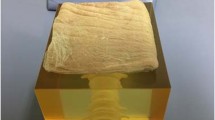Abstract
Objective
The trabecular bone score (TBS) accounts for the bone microarchitecture and is calculated on dual-energy X-ray absorptiometry (DXA). We estimated the reproducibility of the TBS using different scan modes compared to the reproducibility bone mineral density (BMD).
Materials and methods
A spine phantom was used with a Hologic QDR-Discovery A densitometer. For each scan mode [fast array, array, high definition (HD)], 25 scans were automatically performed without phantom repositioning; a further 25 scans were performed with phantom repositioning. For each scan, the TBS was obtained. The coefficient of variation (CoV) was calculated as the ratio between standard deviation and mean; percent least significant change (LSC%) as 2.8×CoV; reproducibility as the complement to 100 % of LSC%. Differences among scan modes were assessed using ANOVA.
Results
Without phantom repositioning, the mean TBS (mm−1) was: 1.352 (fast array), 1.321 (array), and 1.360 (HD); with phantom repositioning, it was 1.345, 1.332, and 1.362, respectively. Reproducibility of the TBS without phantom repositioning was 97.7 % (fast array), 98.3 % (array), and 98.2 % (HD); with phantom repositioning, it was 97.9 %, 98.7 %, and 98.4 %, respectively. LSC% was ≤2.26 %. Differences among scan modes were all statistically significant (p ≤ 0.019). Reproducibility of BMD was 99.1 % with all scan modes, while LSC% was from 0.86 % to 0.91 %.
Conclusion
Reproducibility error of the TBS was 2–3-fold higher than that of BMD. Although statistically significant, differences in TBS among scan modes were within the highest LSC%. Thus, the three scan modes can be considered interchangeable.
Similar content being viewed by others
References
NIH Consensus Development Panel on Osteoporosis Prevention, Diagnosis and Therapy. JAMA. 2001;285:785–95.
Bouxsein ML, Seeman E. Quantifying the material and structural determinants of bone strength. Best Pract Res Clin Rheumatol. 2009;23:741–53.
Kanis JA, Borgstrom F, De Laet C, et al. Assessment of fracture risk. Osteoporos Int. 2005;16:581–9.
Brandi ML. Microarchitecture, the key to bone quality. Rheumatology. 2009;48 Suppl 4:iv3–8.
Wainwright SA, Marshall LM, Ensrud KE, et al. Hip fracture in women without osteoporosis. J Clin Endocrinol Metab. 2005;90:2787–93.
Kanis JA, Hans D, Cooper C, Task Force of the FRAX Initiative, et al. Interpretation and use of FRAX in clinical practice. Osteoporos Int. 2011;22(9):2395–411. doi:10.1007/s00198-011-1713-z.
Pothuaud L, Carceller P, Hans D. Correlations between grey-level variations in 2D projection images (TBS) and 3D microarchitecture: applications in the study of human trabecular bone microarchitecture. Bone. 2008;42:775–87.
Pothuaud L. Process of interpretation of two-dimensional densitometry images for the prediction of bone mechanical strength. Lecture notes in computer science. Springer-Verlag GmbH; 2004. p. 1079–80.
Hans D, Barthe N, Boutroy S, Pothuaud L, Winzenrieth R, Krieg MA. Correlations between trabecular bone score, measured using anteroposterior dual-energy X-ray absorptiometry acquisition, and 3-dimensional parameters of bone microarchitecture: an experimental study on human cadaver vertebrae. J Clin Densitom. 2011;14(3):302–12. doi:10.1016/j.jocd.2011.05.005.
Delnevo A, Bandirali M, Di Leo G, et al. Differences among array, fast array, and high-definition scan modes in bone mineral density measurement at dual-energy x-ray absorptiometry on a phantom. Clin Radiol. 2013;68(6):616–9. doi:10.1016/j.crad.2012.11.017.
Bousson V et al. Trabecular bone score (TBS): available knowledge, clinical relevance, and future prospects. Osteoporos Int. 2012;23:1489–501.
Lewiecki EM, Gordon CM, Baim S, et al. Special report on the 2007 adult and pediatric Position Development Conferences of the International Society for clinical densitometry. Osteoporos Int. 2008;19(10):1369–78. doi:10.1007/s00198-008-0689-9.
Blake GM, Fogelman I. Role of dual-energy X-ray absorptiometry in the diagnosis and treatment of osteoporosis. J Clin Densitom. 2007;10(1):102–10.
Bandirali M, Sconfienza LM, Aliprandi A, et al. In vivo differences among scan modes in bone mineral density measurement at dual-energy X-ray absorptiometry. Radiol Med. 2014;119(4):257–60. doi:10.1007/s11547-013-0342-3.
Bandirali M, Lanza E, Messina C et al. Dose Absorption in Lumbar and Femoral Dual Energy X-ray absorptiometry examinations using three different scan modalities: an anthropomorphic phantom study. J Clin Densitom. 2013;24. doi:10.1016/j.jocd.2013.02.005.
Conflict of interest
The authors declare that they have no conflict of interest.
Author information
Authors and Affiliations
Corresponding author
Rights and permissions
About this article
Cite this article
Bandirali, M., Di Leo, G., Messina, C. et al. Reproducibility of trabecular bone score with different scan modes using dual-energy X-ray absorptiometry: a phantom study. Skeletal Radiol 44, 573–576 (2015). https://doi.org/10.1007/s00256-014-1980-9
Received:
Revised:
Accepted:
Published:
Issue Date:
DOI: https://doi.org/10.1007/s00256-014-1980-9




